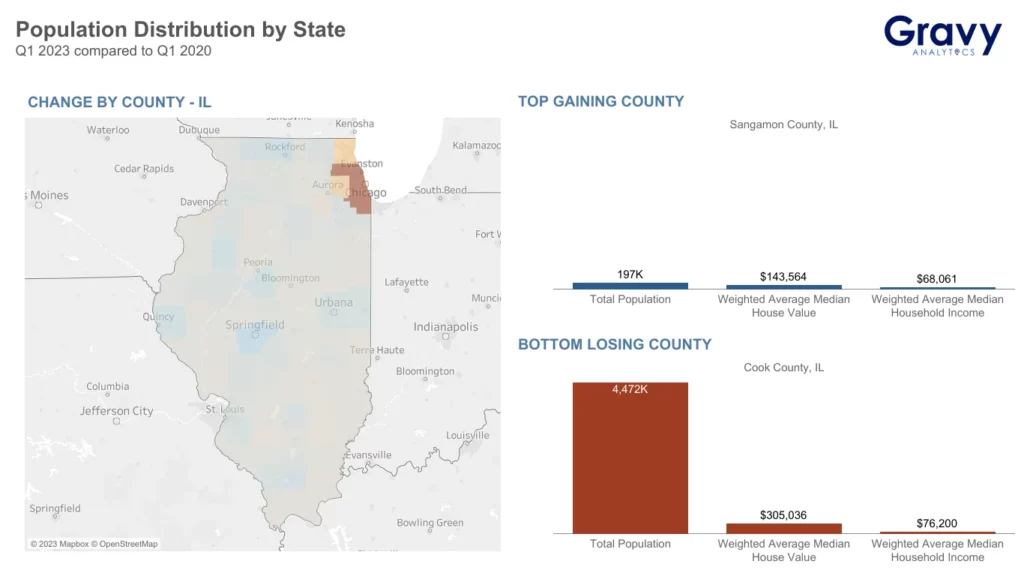Here’s What Location Intelligence Reveals About The Population of Illinois
August 10, 2023

The state of Illinois has a rich history that has contributed much to American culture, making it a popular state among tourists, particularly the city of Chicago. The Windy City is a frequent destination for both domestic and international travelers and the most populous city in Illinois. So, while areas like Chicago fuel consumer foot traffic in Illinois, how could that change in 2023? Additionally, what factors may be influencing population shifts in the state? In recent years, Illinois has reportedly lost more of its population than almost any other state, so we wanted to dig deeper into its changing population with location analytics.

To do so, we examined consumer location data from Q1 2020 to Q1 2023 and compiled our insights in our recent population movement report. Here’s what we learned in the state of Illinois.
Population Movement Trends in Illinois
We used location analytics to determine which counties in Illinois have been gaining and losing the most population. For the time period we analyzed, Sangamon County welcomed more new residents than any other Illinois county. Sangamon County is home to Illinois’ capital, Springfield, so incoming residents may be drawn to this location more than others in the state due to its rich history, reasonable cost of living, and local food scene. As the seventh-largest city in the state, Sangamon County currently has a population of 197,000.
On the other hand, Cook County lost more population than any other county in the state of Illinois—and in the entire country. Cook County is home to the city of Chicago, and the adjacent counties of Lake and DuPage also lost a fair amount of residents. It seems that most of Illinois’ population loss has happened in the northeast region of the state, in the Chicago area. Meanwhile, the counties that have gained population in the last few years are spread out across the state, with a focus on the Springfield area. So, what could be causing this disparity between the population in the Chicago area and the rest of Illinois?

Illinois Housing Costs & Population Movement
In our study, we found that housing costs were a major factor affecting migration patterns across the U.S. Housing costs in Illinois likely fueled migration from the Chicago area to elsewhere in the state, similar to what we saw in other states, including Florida and Texas. After enriching our location data with census data, we discovered that the weighted average median home value in Cook County, Illinois is $305,036, but just $143,564 in Sangamon County. It seems that Illinois residents are overwhelmingly seeking housing in smaller and more affordable markets.
Housing costs in Illinois are about 8% lower than the national average, but in the city of Chicago, that number soars to 20% higher than the national average. As Americans continue to grapple with the post-pandemic economy, including escalating inflation and surging housing prices, it makes sense that consumers would be leaving the Chicago area for areas with more affordable housing. To learn more about trends across other states and counties in the U.S., download the full population movement report.
Major Metros vs. Smaller Markets
Not only are housing costs fueling migration trends in the U.S., but there may be another factor at play: rising consumer interest in smaller markets. In Illinois last year, rural areas experienced the smallest decline in population, while the state’s larger cities experienced the greatest losses in population. In fact, last year, Chicago saw the second-greatest population decline in the country, just behind New York City. Our data tells a more nuanced story: Overwhelmingly, the distribution of consumer mobile devices shifted from the country’s largest cities to smaller cities, like Springfield, IL.
The pandemic played a major role in consumers’ interest in suburban and rural living. As pandemic restrictions forced a widespread shift from in-office work to remote work, more Americans found themselves working from home and deciding to relocate. Due to the rise in remote work, the locations in which many consumers live and work are no longer tied; a recent survey found that 66% of Americans would consider moving to a more rural area. This could make for stronger migration patterns to smaller markets in Illinois and the rest of the country, leading to shifts in local economies, with increased consumer foot traffic, and demand for goods and services in these areas. It will be interesting to see how this migration trend will affect consumer foot traffic trends both in Illinois and across the nation.
Our Population Movement Study
These state insights come from our recent report on the current distribution of population across the country, which examined the impact of various factors on population movement trends. Our reliable location data allowed for accurate consumer insights and interesting findings on the current population of Illinois.
Learning about these population movement patterns over time can help us better understand consumer needs, desires, and preferences. These insights can also help local governments and business organizations better prepare for future population shifts. By understanding what drives people away from certain locations and to new ones, researchers can anticipate movement patterns that may impact local housing, businesses, and public services in the future and maintain a real-world understanding of consumer needs. Insights like these can inform decisions for site selection, transportation, and even location-based marketing, among many other things.
Download the full State of U.S. Population Movement report today for more information about our methodology, our data, and our findings in this population movement study.




